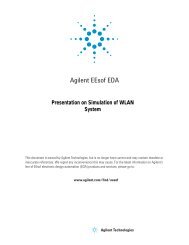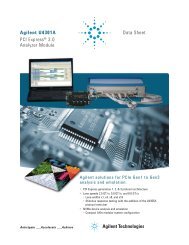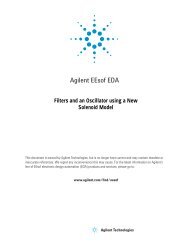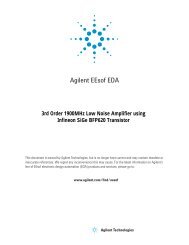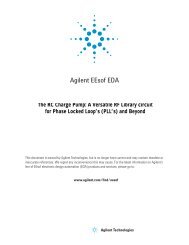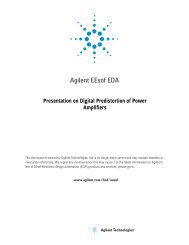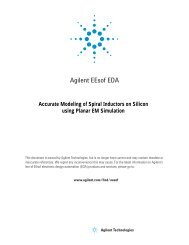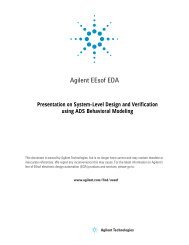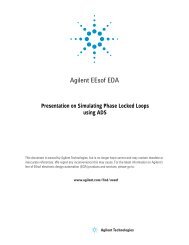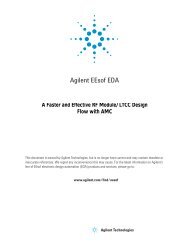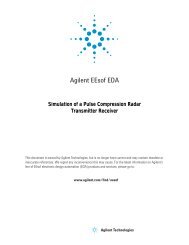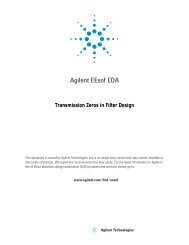Agilent 34980A Multifunction Switch/Measure Unit *34980-90005*
Agilent 34980A Multifunction Switch/Measure Unit *34980-90005*
Agilent 34980A Multifunction Switch/Measure Unit *34980-90005*
You also want an ePaper? Increase the reach of your titles
YUMPU automatically turns print PDFs into web optimized ePapers that Google loves.
1 Introduction to the <strong>34980A</strong><br />
If the input signal is an ac voltage, a converter is used to convert the<br />
ac signal to its equivalent dc value (true RMS value).<br />
Resistance measurements are performed by supplying a known dc<br />
current to an unknown resistance and measuring the dc voltage drop<br />
across the resistor. The input signal switching and ranging circuitry,<br />
together with the amplifier circuitry, convert the input to a dc voltage<br />
which is within the measuring range of the internal DMM's<br />
analog- to- digital converter (ADC).<br />
You can allow the instrument to automatically select the measurement<br />
range using autoranging or you can select a fixed measurement range<br />
using manual ranging. Autoranging is convenient because the instrument<br />
automatically decides which range to use for each measurement based on<br />
the input signal. For fastest scanning operation, use manual ranging for<br />
each measurement (some additional time is required for autoranging<br />
since the instrument has to make a range selection).<br />
Analog-to-Digital Conversion (ADC)<br />
The ADC takes a prescaled dc voltage from the signal- conditioning<br />
circuitry and converts it to digital data for output and display on the<br />
<strong>34980A</strong> front panel. The ADC governs some of the most basic<br />
measurement characteristics. These include measurement resolution,<br />
reading speed, and the ability to reject spurious noise.<br />
There are several analog- to- digital conversion techniques but they can be<br />
divided into two types: integrating and non- integrating. The integrating<br />
techniques measure the average input value over a defined time interval,<br />
thus rejecting many noise sources. The non- integrating techniques sample<br />
the instantaneous value of the input, plus noise, during a very short<br />
interval. The <strong>34980A</strong>'s internal DMM uses an integrating ADC technique.<br />
You can select the resolution and reading speed from 6 digits (22 bits) at<br />
3 readings per second to 4 digits (16 bits) at up to 3,000 readings per<br />
second. The integration time, resolution, and number of digits are all<br />
interrelated (see “Custom A/D Integration Time” on page 88 for more<br />
details).<br />
Main System Processor<br />
The main system processor controls the input signal conditioning,<br />
ranging, the ADC, and all backplane transactions. The main system<br />
processor synchronizes measurements during scanning and control<br />
operations. The main system processor uses a multi- tasking operating<br />
system to manage the various system resources and demands.<br />
The main system processor also performs Mx+B scaling operations,<br />
monitors alarm conditions, converts transducer measurements to<br />
engineering units, adds time stamp information to scanned<br />
measurements, and stores measurement data in memory.<br />
12 <strong>Agilent</strong> <strong>34980A</strong> Mainframe User’s Guide





